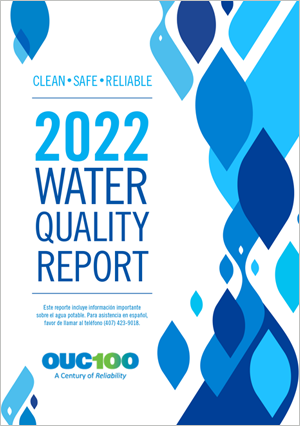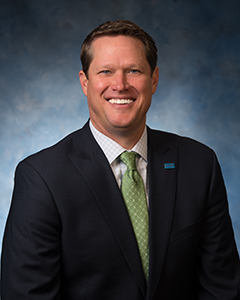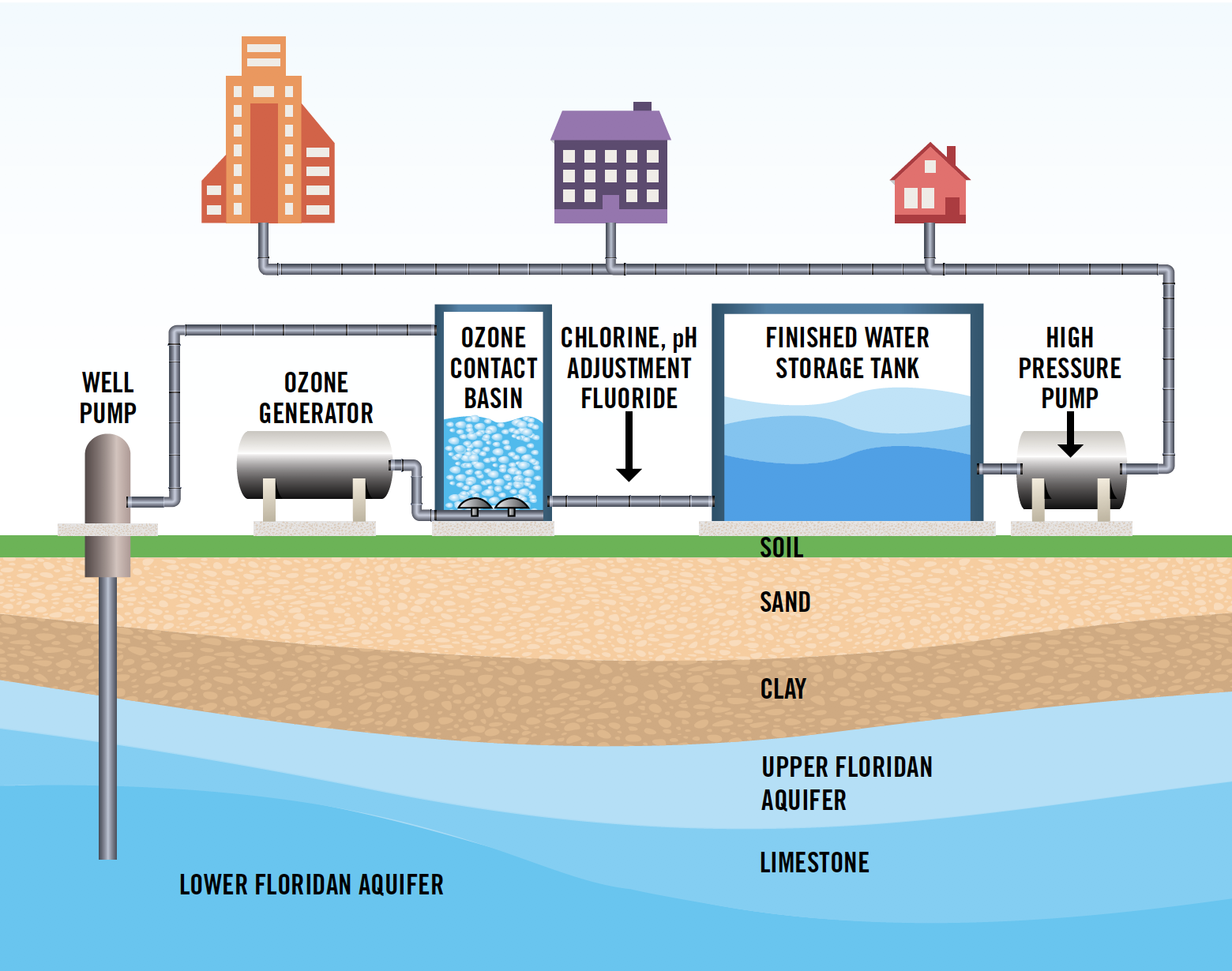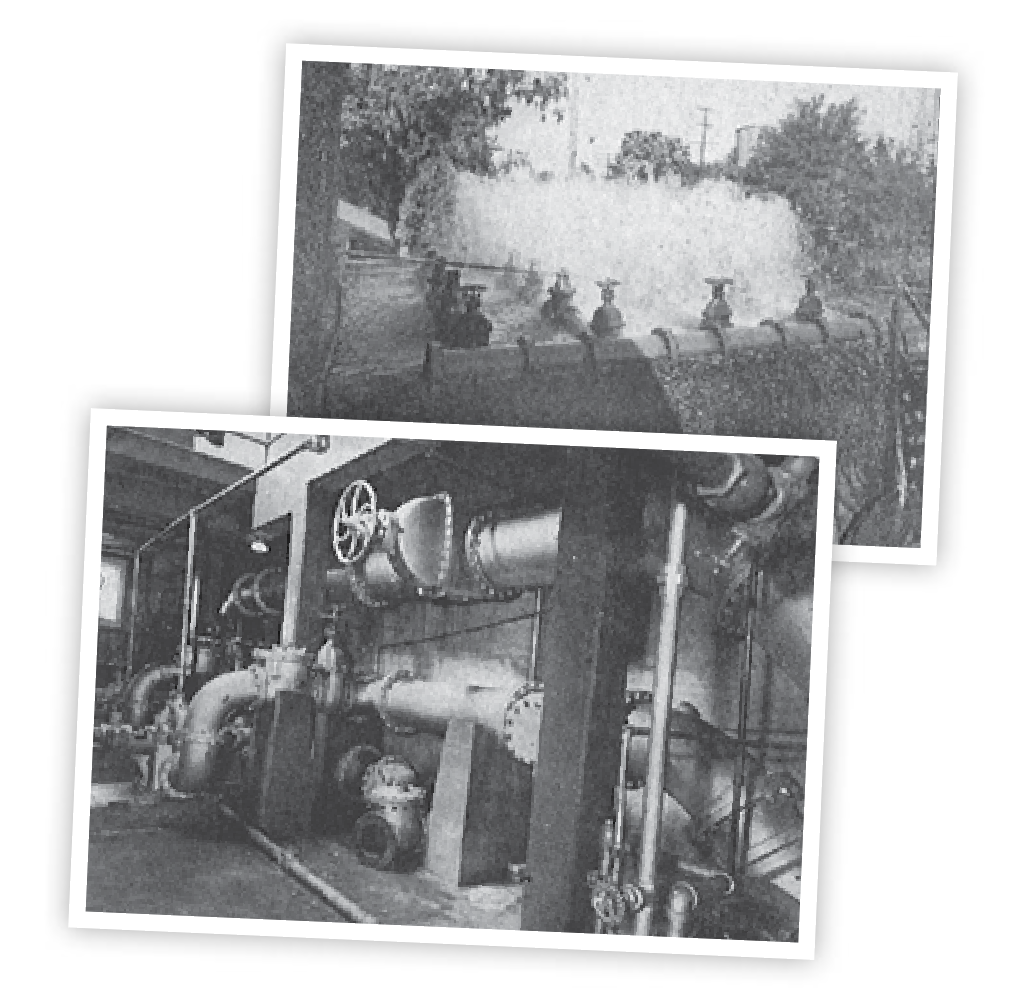2022 Water Quality Report
 CLEAN • SAFE • RELIABLE
CLEAN • SAFE • RELIABLE
A Naturally Clean Water Source
OUC’s water comes from the Lower Floridan aquifer, an underground reservoir that, in many places, is a quarter-mile below parts of the Earth’s surface. The aquifer is fed by rainwater that goes through a filtration process as it seeps through hundreds of feet of sand and rock. OUC pumps water from the aquifer to facilities where it’s treated to meet standards that ensure the water is safe to drink.
Promoting Water Conservation
OUC works year-round to educate the community about the importance of protecting such a precious — and limited — natural resource. From water-conservation themed events, campaigns and student projects to proactive traditional and social media outreach during times of low rainfall or drought, we are committed to helping our customers understand the vital role water plays in everyday life and how crucial their role is in protecting it.
OUC also offers services that help customers become water-wise consumers. Our conservation team conducts home audits to search for potential sources of water loss and make recommendations on improvements. Some recommended upgrades are eligible for OUC rebates, including low-volume irrigation systems, ultra-low-flow toilets, and water cisterns. Customers also have online access to water conservation tips and videos covering such topics as leak detection, water-wise landscaping, faucet aerators, and more. For additional information, visit OUC.com/water.
Ozone Process Produces Great-Tasting Tap Water
OUC uses ozone treatment at our seven water-service plants as part of a process to produce high-quality, great-tasting tap water we call H2OUC. Ozone oxidizes hydrogen sulfide to improve taste, eliminate odor and reduce the amount of chlorine that’s added to water. By law, we are required to add chlorine to our water to maintain its high quality as it flows through pipes to customers’ taps. Fluoride also is added to promote healthy teeth, and we add sodium hydroxide to adjust the pH, preventing copper and lead from leaching into the drinking water from customers’ plumbing, the primary source of these elements.
Protecting Our Water Facilities
Because the safety of your water is of the utmost importance, OUC goes to great lengths to keep our water treatment facilities secure. All OUC water plants are equipped with state-of-the-art security, including intrusion-detection systems, alarms, cameras and fences around the perimeter of properties. Armed security guards and law enforcement officers regularly patrol the facilities.
 At OUC—The Reliable One, our employees are committed to delivering clean, safe, great-tasting water to our customers for not only today, but for generations to come. The 2022 OUC Water Quality Report supports this commitment with a compilation of test results and other important information about the quality of the water you drink and our efforts to conserve it.
At OUC—The Reliable One, our employees are committed to delivering clean, safe, great-tasting water to our customers for not only today, but for generations to come. The 2022 OUC Water Quality Report supports this commitment with a compilation of test results and other important information about the quality of the water you drink and our efforts to conserve it.
The source of your drinking water is the Lower Floridan aquifer, a well-protected reservoir located hundreds of feet below ground level. OUC treats this high-quality water with ozone, the strongest disinfectant available, and other agents that fight bacteria in water and corrosion in pipes. Additionally, our statecertified water lab conducts thousands of chemical and bacteriological water-quality tests each year, including tests for more than 135 regulated and unregulated substances like lead and copper. Summaries of those test results are included in this report.
Water is our most precious – yet limited – natural resource. Therefore, we understand that fostering a water-wise culture is crucial to ensuring an adequate water supply well into the future.
One way we achieve this is by conducting educational initiatives with students in our service territory. Since 2006, more than 125,000 students have participated in our award-winning Project AWESOME (Alternative Water & Energy Supply, Observation, Methods and Education) and Water Color Project. Both programs seek to make students aware of the importance of water conservation and adopt what they learn in their own homes.
OUC also helps residential and business customers become more water-wise by offering programs and rebates that support water conservation. Customers can request a free in-home conservation audit to identify ways to reduce their water consumption. And significant investments in innovative technologies, such as smart water meters and leak detection monitoring, allow us to proactively alert customers and identify areas for improvement regarding consumption and our water infrastructure.
I hope the 2022 Water Quality Report reassures you that we are a responsible steward of the public’s water supply. If you have questions or concerns about water quality or conservation, please don’t hesitate to contact OUC’s Water Quality Lab at 407-434-2549.
— Clint Bullock

OUC General Manager & CEO
Through water-conservation-themed classroom programs, OUC is teaching public school students about the importance of preserving and protecting Florida’s water supply. Since 2006, more than 125,000 local students have participated in OUC’s Water Color Project and Project AWESOME (Alternative Water & Energy Supply, Observation, Methods and Education). The Water Color Project encourages Orange County students to use their artistic talents to promote conservation. Fourth- and fifth-graders compete to have their artwork featured in OUC’s annual Water Conservation Calendar while middle and high school students paint water-themed rain barrels for judging.
Project AWESOME delivers an interactive lab to fifth-graders in Orange and Osceola counties. Students make an aquifer, build solar-powered cars and validate the efficiency of low-flow showerheads and compact fluorescent light bulbs (CFLs).
OUC’s efforts to spread the word on water conservation go beyond the classroom. Everyone can help save water by following a few simple tips:
- Water just once per week in cooler months and twice per week in warmer months in accordance with the SJRWMD watering restrictions at www.sjrwmd.com/wateringrestrictions.
- Water your lawn before 10 a.m. or after 4 p.m. to minimize the amount lost to evaporation.
- Water your lawn for just 35-45 minutes per session. Turn off your irrigation system if it has rained.
- Repair leaking faucets and toilets.
- Install water-saver shower heads and take shorter showers.
For more ways to save water, visit OUC.com/waterconservation.
Well pumps at OUC’s water treatment plants draw water from a natural underground reservoir called the Lower Floridan aquifer. After being sent through ozone contact basins, the water is treated with chlorine and fluoride. The water is then pumped into a finished water storage tank and distributed to residential, commercial and industrial customers. OUC pumps about 31.5 billion gallons of water per year to customers across a 200-square-mile service area.

 The foundation for what would eventually become the Orlando Utilities Commission was laid even before the 20th century began. Through much of the 1800s, the community’s only source of water was a town well located next to the Orange County Court House at the corner of Central and Main.
The foundation for what would eventually become the Orlando Utilities Commission was laid even before the 20th century began. Through much of the 1800s, the community’s only source of water was a town well located next to the Orange County Court House at the corner of Central and Main.
The Orlando Water Company was formed in 1886 and consisted of a plant and distribution system, which used Lake Highland as its source. In 1889, additional water mains – including about 13.5 miles of pipe – were laid to serve many areas of Orlando with a safe domestic supply and fire protection.
Four years later, a foreclosure resulted in a new corporation, the Orlando Water and Sewerage Company, which was purchased within a year to form the Orlando Water & Light Company (OWLC). Using an additional water supply, Lake Concord, OWLC boosted the system to 23 miles of mains and pipes, covering every part of the City and more than 100 fire hydrants. In 1917, the first filtrated treatment facilities were built to begin treating lake water before passing it into the city mains.
In 1922, the City of Orlando purchased OWLC to form the Orlando Utilities Commission. OUC—The Reliable One, as you know us today, pumps water from the pristine Lower Floridan aquifer to provide safe, clean, great-tasting water to the residents of Orlando and parts of unincorporated Orange County.
OUC’s water pumping equipment from the 1930s.
Sources of drinking water (both tap and bottled) include rivers, lakes, streams, ponds, reservoirs, springs and wells. As water travels over the surface of land or through the ground, it dissolves naturally occurring, and, in some cases, radioactive materials. But it also picks up substances related to animals or human activity. Contaminants that may be present in source water include:
-
Microbial contaminants, such as viruses and bacteria, which may come from sewage treatment plants, septic systems, agricultural livestock operations and wildlife.
- Inorganic contaminants, such as salts and metals, which can be naturally occurring or result from urban stormwater runoff, industrial or domestic wastewater discharges, oil and gas production, mining or farming.
- Pesticides and herbicides, which may come from a variety of sources such as agriculture, urban stormwater runoff and residential uses.
- Organic chemical contaminants, including synthetic and volatile organic chemicals, which are by-products of industrial processes and petroleum production and can come from gas stations, urban stormwater runoff and septic systems.
- Radioactive contaminants, which can be naturally occurring or the result of oil and gas production, and mining activities.
In order to ensure that tap water provided by public water systems is safe to drink, the EPA prescribes regulations that limit the amounts of certain contaminants in water. Meanwhile, the U.S. Food and Drug Administration regulates limits for contaminants in bottled water, which must provide the same protection for public health.
All drinking water, including bottled water, may be reasonably expected to contain minute amounts of some contaminants. The presence of contaminants in water does not necessarily pose health risks. More information about contaminants and potential health effects can be obtained by calling the EPA Safe Drinking Water Hotline at 1-800-426-4791.
What The EPA Says About MCLs And Health Effects
The Maximum Contaminant Levels (MCLs) established by the EPA are set at very stringent levels. To understand the possible health effects described for many regulated constituents, a person would have to drink two liters of water every day at the MCL level for a lifetime to have a one-in-a-million chance of having the described health effect.
Some people may be more vulnerable to contaminants in drinking water than the general population. Immuno-compromised people, such as those with cancer who are undergoing chemotherapy, those who have undergone organ transplants, those with HIV/AIDS or other immune system disorders, and some elderly and infants, can be particularly at risk for infections. These people should consult with their healthcare providers about drinking water. EPA and Center for Disease Control and Prevention guidelines on appropriate means to lessen the risk of infection by cryptosporidium and other microbial contaminants are available from the EPA Safe Drinking Water Hotline at 1-800-426-4791.
MCL: Maximum Contaminant Level.
The highest level of a contaminant that is allowed in drinking water. MCLs are set as close to the MCLGs as feasible using the best available treatment technology.
MCLG: Maximum Contaminant Level Goal.
The level of a contaminant in drinking water below which there is no known or expected risk to health. MCLGs allow for a margin of safety.
AL: Action Level.
The concentration of a contaminant which, if exceeded, triggers treatment or other requirements that a water system must follow.
ppm: Parts Per Million.
One part by weight of analyte to 1 million parts by weight of the water sample.
ppb: Parts Per Billion.
One part by weight of analyte to 1 billion parts by weight of the water sample.
LRAA: Locational Running Annual Average.
The average of sample analytical results for samples taken at a particular monitoring location during the previous four calendar quarters.
RAA: Running Annual Average.
The average of results computed quarterly, of monthly averages of all samples collected during the previous four calendar quarters.
N/A: Not Applicable.
ND: Not Detected.
Indicates that the substance was not found by laboratory analysis.
MRDLG: Maximum Residual Disinfectant Level Goal.
The level of a drinking water disinfectant below which there is no known or expected risk to health. MRDLGs do not reflect the benefits of the use of disinfectants to control microbial contaminants.
MRDL: Maximum Residual Disinfectant Level.
The highest level of a disinfectant allowed in drinking water. There is convincing evidence that addition of a disinfectant is necessary for control of microbial contaminants.
MFL: Million Fibers Per Liter.
Measure of the presence of asbestos fibers that are longer than 10 micrometers.
Water Quality Test Results
All test results well below allowable levels
As shown in the following tables, OUC routinely monitors for contaminants in your drinking water according to Federal and State laws, rules, and regulations. Except where indicated otherwise, this report is based on the results of our monitoring for the period of January 1 to December 31, 2022. Data obtained before January 1, 2022, and presented in this report is from the most recent testing done in accordance with the laws, rules, and regulations.
Results of Copper and Lead
Sampling at Customer Taps
The following results are from tests conducted in July 2020 (the most recent available in accordance with FDEP regulations). The tests confirm that the levels of lead and copper in tap water sampled in homes were below the Action Level (AL).
About OUC—The Reliable One
OUC is a municipal utility owned by the citizens of Orlando and governed by a board of commissioners. As the second largest municipal utility in Florida and 14th largest municipal in the country, OUC provides electric, water, chilled water and/or lighting services to 400,000 customer accounts in Orlando, St. Cloud and parts of unincorporated Orange and Osceola counties. OUC is one of the largest water utilities in the state and serves a population of more than 442,000.